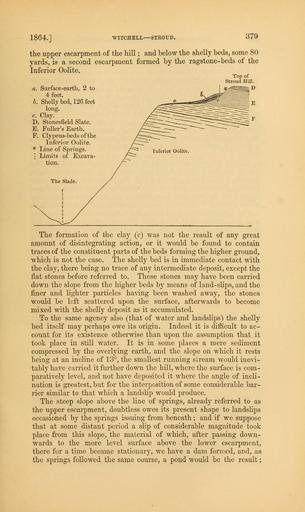MAKE A MEME
View Large Image

| View Original: | The_Quarterly_journal_of_the_Geological_Society_of_London_(12895114593).jpg (1226x2061) | |||
| Download: | Original | Medium | Small | Thumb |
| Courtesy of: | commons.wikimedia.org | More Like This | ||
| Keywords: The Quarterly journal of the Geological Society of London (12895114593).jpg 1864 <br> WITCHELL STROUD <br> 379 <br> the upper escarpment of the hill ; and below the shelly beds some 80 <br> yards is a second escarpment formed by the ragstone-beds of the <br> Inferior Oolite <br> Top of <br> Stroud Hill <br> a Surface-earth 2 to <br> 4 feet <br> b Shelly bed 126 feet <br> long <br> c Clay <br> D Stonesfield Slate <br> E Fuller's Earth <br> F Clypeus-beds of the <br> Inferior Oolite <br> Line of Springs <br> Limits of Excava- <br> tion <br> The formation of the clay c was not the result of any great <br> amount of disintegrating action or it would be found to contain <br> traces of the constituent parts of the beds forming the higher ground <br> which is not the case The shelly bed is in immediate contact with <br> the clay there being no trace of any intermediate deposit except the <br> flat stones before referred to These stones may have been carried <br> down the slope from the higher beds by means of land-slips and the <br> finer and lighter particles having been washed away the stones <br> would be left scattered upon the surface afterwards to become <br> mixed with the shelly deposit as it accumulated <br> To the same agency also that of water and landslips the shelly <br> bed itself may perhaps owe its origin Indeed it is difficult to ac- <br> count for its existence otherwise than upon the assumption that it <br> took place in still water It is in some places a mere sediment <br> compressed by the overlying earth and the slope on which it rests <br> being at an incline of 13° the smallest running stream would inevi- <br> tably have carried it further down the hill where the surface is com- <br> paratively level and not have deposited it where the angle of incli- <br> nation is greatest but for the interposition of some considerable bar- <br> rier similar to that which a landslip would produce <br> The steep slope above the line of springs already referred to as <br> the upper escarpment doubtless owes its present shape to landslips <br> occasioned by the springs issuing from beneath ; and if we suppose <br> that at some distant period a slip of considerable magnitude took <br> place from this slope the material of which after passing down- <br> wards to the more level surface above the lower escarpment <br> there for a time became stationary we have a dam formed and as <br> the springs followed the same course a pond would be the result ; 36089644 111261 51125 Page 379 Text v 20 http //www biodiversitylibrary org/page/36089644 1864 Geological Society of London Biodiversity Heritage Library The Quarterly journal of the Geological Society of London v 20 1864 Geology Periodicals Smithsonian Libraries bhl page 36089644 dc identifier http //biodiversitylibrary org/page/36089644 smithsonian libraries Information field Flickr posted date ISOdate 2014-03-03 Check categories 2015 August 26 CC-BY-2 0 BioDivLibrary https //flickr com/photos/61021753 N02/12895114593 2015-08-26 16 56 03 cc-by-2 0 PD-old-70-1923 The Quarterly journal of the Geological Society of London 1864 Photos uploaded from Flickr by Fæ using a script | ||||